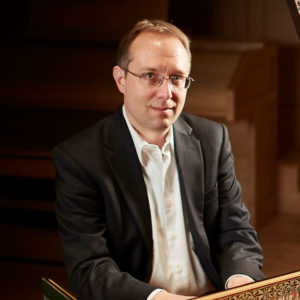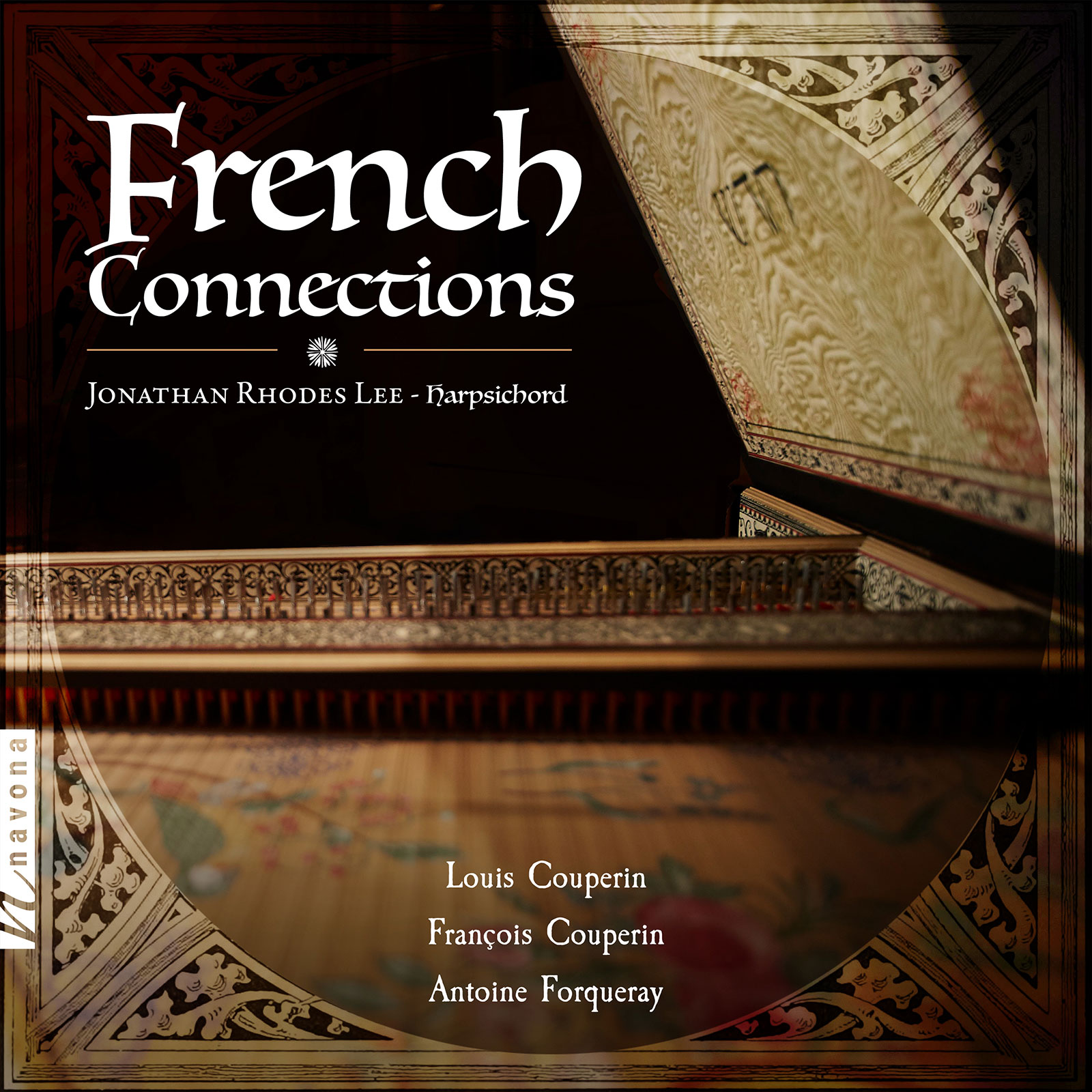French Connections
Jonathan Rhodes Lee harpsichord
Louis Couperin composer
François Couperin composer
Antoine Forqueray composer
Navona Records presents FRENCH CONNECTIONS, a new album of French works for harpsichord performed by Jonathan Rhodes Lee. The pieces selected for this collection celebrate the small, tight-knit pantheon of 17th-century French harpsichordists who helped shape the instrument’s repertoire. While the total output of these composers would make for countless hours of listening, FRENCH CONNECTIONS offers a taste of this expansive body of work. Music by Louis Couperin (c. 1626-1661), François Couperin (1668-1733) and Antoine Forqueray (1672-1745) comes alive through masterful performances by Lee, with recordings engineered and mastered by multiple GRAMMY-winning classical music producer Brad Michel.
Listen
Stream/Buy
Choose your platform
Track Listing & Credits
| # | Title | Composer | Performer | |
|---|---|---|---|---|
| 01 | Pieces in F: Prélude | Louis Couperin | Jonathan Rhodes Lee, harpsichord | 2:42 |
| 02 | Pieces in F: Allemande Grave | Louis Couperin | Jonathan Rhodes Lee, harpsichord | 3:55 |
| 03 | Pieces in F: Courante | Louis Couperin | Jonathan Rhodes Lee, harpsichord | 1:31 |
| 04 | Pieces in F: Branle De Basque | Louis Couperin | Jonathan Rhodes Lee, harpsichord | 0:41 |
| 05 | Pieces in F: Chaconne | Louis Couperin | Jonathan Rhodes Lee, harpsichord | 3:11 |
| 06 | 17th ordre: La Superbe, Ou La Forqueray | François Couperin | Jonathan Rhodes Lee, harpsichord | 5:14 |
| 07 | 17th ordre: Les Petits Moulins À Vent | François Couperin | Jonathan Rhodes Lee, harpsichord | 2:04 |
| 08 | 17th ordre: Les Timbres | François Couperin | Jonathan Rhodes Lee, harpsichord | 3:02 |
| 09 | 17th ordre: Courante | François Couperin | Jonathan Rhodes Lee, harpsichord | 2:43 |
| 10 | 17th ordre: Les Petites Chrémiéres De Bagnolet | François Couperin | Jonathan Rhodes Lee, harpsichord | 2:09 |
| 11 | Selections from Suite no. 5: La Rameau | Antoine Forqueray, arr. Jean-Baptiste Forqueray | Jonathan Rhodes Lee, harpsichord | 4:47 |
| 12 | Selections from Suite no. 5: La Boisson | Antoine Forqueray, arr. Jean-Baptiste Forqueray | Jonathan Rhodes Lee, harpsichord | 5:17 |
| 13 | Selections from Suite no. 5: La Sylva | Antoine Forqueray, arr. Jean-Baptiste Forqueray | Jonathan Rhodes Lee, harpsichord | 6:10 |
| 14 | Selections from Suite no. 5: Jupiter | Antoine Forqueray, arr. Jean-Baptiste Forqueray | Jonathan Rhodes Lee, harpsichord | 7:42 |
All tracks recorded at Dana Arts Center, Colgate University in Hamilton NY
Recording Session Producer Joseph Swain
Recording Session Engineer Edwin Vollmer
Editing and Mastering Brad Michel
Harpsichord by Carl Fudge
Photography by Josh Hawkins
This recording is funded in part by a generous grant from the College of Fine Arts at the University of Nevada, Las Vegas www.unlv.edu/finearts
Executive Producer Bob Lord
Executive A&R Sam Renshaw
A&R Director Brandon MacNeil
VP of Production Jan Košulič
Audio Director Lucas Paquette
VP, Design & Marketing Brett Picknell
Art Director Ryan Harrison
Design Edward A. Fleming
Publicity Patrick Niland, Sara Warner
Artist Information

Jonathan Rhodes Lee
Jonathan Rhodes Lee is Associate Professor of Music at the University of Nevada, Las Vegas. He studied harpsichord with Laurette Goldberg, Joscelyn Godwin, Davitt Moroney, and Jacques Ogg. He holds degrees from the San Francisco Conservatory of Music and the University of California, Berkeley, and he was a Fulbright Scholar at the Royal Conservatory of Music in The Hague, Netherlands. Lee’s work as a musicologist focuses on 18th-century repertoires and film music, and his recordings can be heard on the MSR, Equilibrium, and Navona labels.
Notes
Harpsichordists in 17th-century France comprised a highly prized and tightly knit group of musicians. The pieces on this recording emphasize the interconnectedness of this small circle through various references in the works themselves.
The first generation of court harpsichordists in the mid-17th century consisted of three younger colleagues of (and possibly students of) Jacques Champion de Chambonnières: Louis Couperin, Jean Henry D’Anglebert, and Nicolas Lebègue. The overlap between these musicians’ styles and approaches in their dance suites creates an identifiable “school” of harpsichord composition. Of these men, Couperin has perhaps the most recognizable name as progenitor of a family of musicians of significant stature and accomplishment. Couperin’s suite on this recording opens with an unmeasured prelude; we owe a debt to Couperin and his colleagues for developing a flexible notational system to share their quasi-improvisatory genre that Chambonnières mastered but never wrote down. Binary dances that follow remained popular throughout the next century: allemande, courante, sarabande, branle (a raucous little country dance that was also referred to as a “brawl” by English speakers), and chaconne.
This loose organization of dances into suites remained the general rule for French keyboard publications into the 18th century. Louis’s nephew, François Couperin le grand, was among the first to change this pattern by collecting suites of pieces with little nicknames, many of which remain mysterious to this day. This disc’s suite of pieces features a work called “The Little Windmills,” evidently inspired by the turning figuration of the melodic lines, “The Bells,” a sonorous piece with an appropriate name, and the enigmatically titled “The Little Milkmaids of Bagnolet.” The work opens with a grand piece called “La Superbe, ou la Forqueray,” honoring the gambist Antoine Forqueray; Couperin’s piece clearly draws inspiration from the rich low ranges, ornamental approach, and arpeggiated figuration on which Forqueray earned his reputation.
Forqueray’s own music brings the recording to a close. Originally composed for the viol, these works found new expressive possibilities in 1747 arrangements for solo harpsichord by Jean-Baptiste Forqueray, Antoine’s son (published at the same time as the viol compositions). These works make virtuosic demands on players, with appropriately grandiose names. “La Sylva” and “Jupiter” associate Forqueray’s works with godly powers. “La Boisson” counterbalances these divine attributions with its implied earthiness, and the opening piece, “La Rameau,” honors a then living and famous member of the harpsichord world, Jean-Philippe Rameau. Rameau’s music may not appear on this disc, but the adventurous harmonic experiments of Forqueray’s piece gives us a sense of what Rameau’s forward-looking work would have sounded like to an 18th-century musician. It also reminds us that a program of French connections could go on to fill many discs; the small, tightly connected group of musicians whom people today sometimes call clavecinistes recognized and honored one another’s accomplishments through their body of work, providing us with ever expandable networks of associations.
— Jonathan Rhodes Lee

